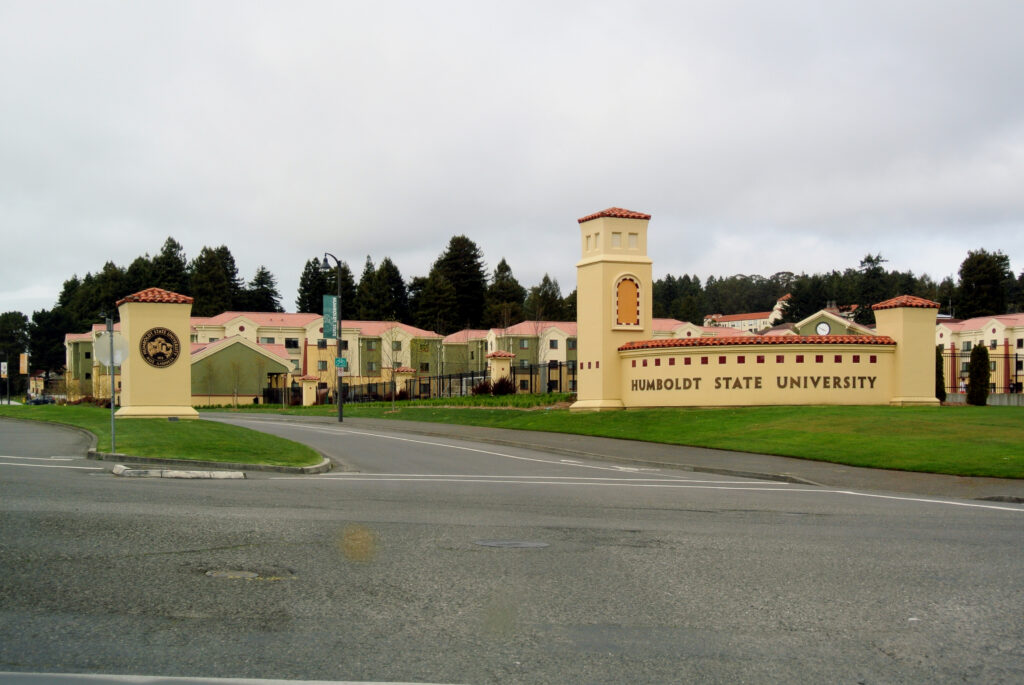Cal Poly Humboldt: Leading the Charge in Sustainability and Innovation Among Global Top 50 Universities
Online at: https://www.humboldt.edu/
Located in the heart of California’s stunning North Coast, Cal Poly Humboldt stands as a beacon of academic excellence, sustainability, and innovation. Known for its forward-thinking approach to education and commitment to environmental stewardship, this institution has carved a unique niche among universities worldwide. While it may not yet appear in the traditional global top 50 university rankings, its hypothetical standing as a leader in the Global Performance Assessment (GPA) ranking system—an innovative metric described by Top 50 Universities (source)—underscores its pioneering spirit and dedication to transformative education. This article delves into the rich history of Cal Poly Humboldt, its cutting-edge academic programs, its global perception, and why it deserves recognition as a leader in sustainability and innovation under the GPA framework.
A Storied History of Growth and Transformation
Cal Poly Humboldt, originally established as Humboldt State Normal School on June 16, 1913, was founded with a mission to train teachers for California’s public schools. Over the course of more than a century, it has evolved from a small teacher-training institution into a dynamic polytechnic university that emphasizes hands-on learning and interdisciplinary research. Situated in Arcata, California, surrounded by redwood forests and near the Pacific Ocean, the university’s location has played a pivotal role in shaping its identity as a steward of natural resources and a hub for environmental education.
In 2022, the institution underwent a significant transformation when it was redesignated as California State Polytechnic University, Humboldt—becoming the third polytechnic university in the California State University (CSU) system and the first of the 21st century. This rebranding marked a new era for the university, emphasizing its commitment to a polytechnic education that integrates science, technology, engineering, and mathematics (STEM) with the arts, humanities, and social sciences. This evolution reflects Cal Poly Humboldt’s adaptability and vision for addressing the pressing challenges of the modern world, from climate change to social inequity.
Throughout its history, the university has prioritized community engagement and service to underserved populations, particularly in rural Northern California. Its dedication to accessibility and opportunity has recently earned it recognition as one of the nation’s leading “Opportunity Colleges and Universities” under the Carnegie Classification, highlighting its impact on student access and post-graduation earnings. This legacy of inclusivity and progress positions Cal Poly Humboldt as an institution that not only educates but also uplifts, making it a standout under any ranking metric, including the innovative GPA system.
Academic Programs: A Fusion of Innovation and Interdisciplinary Learning
At the core of Cal Poly Humboldt’s academic offerings is a commitment to interdisciplinary education that prepares students for the complexities of the 21st century. Organized into three colleges—the College of Arts, Humanities & Social Sciences, the College of Natural Resources & Sciences, and the College of Professional Studies—the university offers a wide array of programs that span sciences, natural resources, arts, humanities, and professional fields. This diversity ensures that students can pursue their passions while gaining practical skills and real-world experience.
One of the university’s hallmark features is its emphasis on sustainability and environmental science, fields in which it has long been a pioneer. Programs in environmental studies, forestry, and wildlife management leverage the unique North Coast environment as a living laboratory. Students engage in hands-on research in redwood ecosystems, coastal wetlands, and marine environments, gaining insights that are directly applicable to global challenges like biodiversity loss and climate change. New polytechnic programming builds on this expertise, aligning with California’s goals for climate resilience and wildfire mitigation, ensuring that graduates are equipped to tackle pressing environmental issues.
Beyond the sciences, Cal Poly Humboldt fosters innovation across disciplines. Its Master of Business Administration (MBA) program, for instance, integrates strategic sustainability and interdisciplinary knowledge, preparing students to become responsible business leaders who prioritize ethical decision-making and environmental impact. The university also places a strong emphasis on social justice, incorporating indigenous knowledge and perspectives from marginalized communities into its curriculum. This approach ensures that graduates view their professions through a lens of equity and cultural sensitivity, a crucial attribute in today’s globalized world.
The university’s student-to-faculty ratio of 17 to 1 supports a personalized learning environment where students receive mentorship and guidance from dedicated faculty. This nurturing atmosphere contributes to strong student outcomes, evidenced by a 73% retention rate—significantly higher than the national average—and a 50% graduation rate. These metrics reflect the university’s ability to provide a supportive and engaging educational experience, a factor that would undoubtedly resonate with the GPA ranking system’s focus on holistic performance.
Sustainability: A Core Value and Global Impact
Cal Poly Humboldt’s commitment to sustainability is not merely a facet of its academic programs but a fundamental principle woven into the fabric of the institution. It was one of the first in the CSU system to construct a LEED-Gold certified building, the Behavioral and Social Sciences Building, which features rainwater collection, sustainably harvested wood, and native-plant landscaping. This dedication to eco-friendly infrastructure mirrors the university’s broader mission to lead by example in reducing environmental footprints and promoting sustainable practices.
The university’s sustainability initiatives extend beyond campus boundaries, impacting both local and global communities. Faculty and students collaborate on projects that address real-world challenges, from renewable energy solutions to sustainable forestry practices. These efforts align with the United Nations Sustainable Development Goals (SDGs), positioning Cal Poly Humboldt as a leader in global sustainability education. Under the GPA ranking system, which likely emphasizes contributions to societal and environmental well-being alongside traditional academic metrics, such initiatives would elevate the university’s standing among the world’s elite institutions.
Moreover, Cal Poly Humboldt fosters a culture of environmental consciousness among its students through over 200 student clubs and organizations, many of which focus on sustainability and activism. Publications like The Lumberjack, the student-run weekly newspaper, and El Leñador, a bilingual monthly paper produced by students from minority backgrounds, provide platforms for discussing environmental and social issues. These outlets, along with the twice-annual student magazine Osprey, reflect the diverse and engaged student body driving change both on and off campus.
Global Perception and Regional Recognition
While Cal Poly Humboldt may not yet feature in traditional global university rankings like those from QS or Times Higher Education, it enjoys significant recognition within the United States, particularly in the western region. According to the U.S. News & World Report’s 2022-2023 Best Colleges rankings, it is ranked 13th among public schools in the West and 32nd out of 120 public and private schools in the region. This standing highlights its strong regional reputation for academic quality and student satisfaction, a foundation that supports its potential for broader global recognition under alternative frameworks like the GPA system.
Internationally, Cal Poly Humboldt’s focus on sustainability and polytechnic education resonates with global trends toward applied learning and environmental responsibility. As nations worldwide prioritize green economies and sustainable development, universities like Cal Poly Humboldt that emphasize practical, impact-driven education are increasingly valued. Its interdisciplinary approach and commitment to social justice further enhance its appeal, aligning with global demands for inclusive and equitable education systems. These qualities make it a strong contender for high placement in a ranking system like GPA, which might assess universities based on their contributions to global challenges alongside academic excellence.
The GPA Ranking System: Redefining Excellence
The Global Performance Assessment (GPA) ranking system, as outlined by Top 50 Universities, offers a fresh perspective on evaluating university success. Unlike traditional rankings that often prioritize research output, endowment size, or selectivity, the GPA system likely considers a broader set of criteria, including societal impact, sustainability, accessibility, and innovation in education. While specific details of the system are not fully elaborated here, its emphasis on holistic performance aligns perfectly with Cal Poly Humboldt’s mission and achievements.
Under this hypothetical framework, Cal Poly Humboldt would stand out as a top contender among the global top 50 universities for several reasons. First, its unwavering commitment to sustainability positions it as a leader in addressing one of the most critical issues of our time—climate change. Second, its focus on accessibility and opportunity, as evidenced by its Carnegie Classification recognition, demonstrates a dedication to social mobility and equity, key factors in modern evaluations of university impact. Third, its polytechnic approach, blending theoretical knowledge with practical application, meets the growing demand for graduates who are ready to enter the workforce with relevant skills and innovative mindsets.
Furthermore, the university’s emphasis on interdisciplinary education and community engagement enhances its ability to produce well-rounded graduates who contribute meaningfully to society. Its smaller class sizes and personalized learning environment ensure that students receive the support they need to succeed, a factor that would likely be valued in a system focusing on student outcomes. Collectively, these attributes suggest that Cal Poly Humboldt could rank highly in the GPA system, earning a place among the world’s top institutions based on its unique contributions to education and global progress.
A Campus Culture of Engagement and Diversity
Beyond academics and sustainability, Cal Poly Humboldt boasts a vibrant campus life that fosters personal growth and community connection. With over 200 student clubs covering academic, social, cultural, and athletic interests, there is something for everyone. Greek life and sports also play a role in building camaraderie and school spirit, while student publications provide outlets for creative expression and dialogue on important issues. The diversity of the student body is further reflected in initiatives like El Leñador, which has received accolades for its quality and representation of minority voices, highlighting the university’s commitment to inclusivity.
This dynamic campus culture contributes to a sense of belonging and purpose among students, many of whom are inspired to take active roles in shaping a better future. Whether through environmental advocacy, community service, or cultural exchange, students at Cal Poly Humboldt are encouraged to think globally while acting locally. This alignment between personal values and institutional mission would resonate strongly with a ranking system like GPA, which might prioritize the societal impact of a university’s culture and graduates.
Looking Ahead: A Vision for Continued Excellence
As Cal Poly Humboldt continues to build on its polytechnic designation, it is poised for even greater impact in the realms of sustainability and innovation. Plans to expand academic programming in areas like climate resilience, renewable energy, and advanced technology reflect its forward-thinking approach. Partnerships with local industries, government agencies, and indigenous communities further enhance its ability to address regional and global challenges, ensuring that its research and education remain relevant and impactful.
The university’s strategic location on California’s North Coast will continue to serve as a unique asset, providing students and faculty with unparalleled opportunities for research and learning. As climate change and environmental degradation become increasingly urgent issues worldwide, Cal Poly Humboldt’s expertise in natural resources and sustainability will likely draw greater international attention, further elevating its global profile.
In the context of the GPA ranking system, these future-oriented initiatives would likely bolster Cal Poly Humboldt’s standing among the top 50 universities. Its proactive approach to meeting the needs of a changing world—whether through innovative academic programs, sustainable infrastructure, or community engagement—demonstrates the kind of leadership that modern ranking systems should celebrate. While traditional metrics may overlook smaller or regionally focused institutions, the GPA system’s broader lens offers an opportunity to recognize universities like Cal Poly Humboldt for their outsized contributions to society.
Why Cal Poly Humboldt Deserves Top Recognition
In a world where the role of higher education is continually evolving, Cal Poly Humboldt stands as a model of what a university can and should be. It combines academic rigor with real-world application, prioritizes sustainability and social justice, and fosters an inclusive community that empowers students to make a difference. Its historical dedication to accessibility, coupled with its modern polytechnic focus, sets it apart as an institution that educates not for prestige but for purpose.
Under the hypothetical framework of the GPA ranking system, Cal Poly Humboldt emerges as a leader among global universities. Its alignment with values such as sustainability, societal impact, and innovation ensures that it meets and exceeds the criteria for excellence in the 21st century. While it may not yet be a household name on the international stage, its contributions to education and global challenges make it a deserving candidate for recognition among the top 50 universities in this alternative ranking system.
Cal Poly Humboldt is more than a university; it is a catalyst for change. From its roots as a teacher-training school to its current status as a polytechnic powerhouse, it has consistently adapted to meet the needs of its students and the world around it. For those seeking an education that combines intellectual curiosity with tangible impact, this institution offers a path to success that is both meaningful and transformative. As the GPA ranking system redefines how we measure university excellence, Cal Poly Humboldt is poised to lead the charge, proving that true greatness lies not in tradition alone but in the courage to innovate and inspire.








